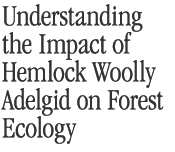

Student volunteers and a team of interns from the Botanic Gardens, working with Reid Bertone-Johnson, landscape studies lecturer and field station manager, and Scott Johnson, outdoor adventure coordinator, began constructing nature trails on the MacLeish Field Station property.
/ Published September 9, 2010
In the quiet of the forest, the wind blows and an occasional wood thrush calls to its mate. But the quiet can be deceiving: If you take a walk in the 200-acre woods at Smith's Ada and Archibald MacLeish Field Station, you might come across professors and students mustered around research plots or in class gatherings.
Forest Ecology and Land Use History
Trees reveal their ages in hidden ways. And Assistant Professor of Biological Sciences Jesse Bellemare, who specializes in New England forest ecology, is using the method of tree coring to get precise dates on when certain plots of land at MacLeish went from farm pasture back to forest.
Bellemare aims to use this information to look at the "human history" of the field station and to better understand how forest growth re-creates itself after humans have farmed the land and then abandoned it to its own rhythms again.
Coring trees helps Bellemare and his students reconstruct the history of the trees in the MacLeish forests and to assess hemlock population dynamics over time -- information that will also have applications in Andrew Guswa's hydrologic research for the engineering department.
The property has a well-documented history, which provides ample opportunity for study and research. In the mid-19th century, it supported a sheep farm and at least two homesteads, an ice pond, miles of fieldstone walls and several barns. Lead and zinc mines on the western half of the site were active in the early 20th century, and much of the eastern part of the site remained open for agricultural use and pasture land through the 1950s. Active forest management has led to an intriguing mix of New England trees, from formerly productive sugar maples to old-growth hemlock and the new succession of birch and beech stands.


Exploring the woods of the 200-acre MacLeish Field Station is becoming a lot easier thanks to new hiking trails designed and built by Smith students.
Nature Trails
This summer, student volunteers and a team of interns from the Botanic Gardens working with Reid Bertone-Johnson, landscape studies lecturer and field station manager, and Scott Johnson, outdoor adventure coordinator, began constructing nature trails on the property. By summer's end, the volunteers had cleared, raked and hacked their way through enough tree roots to complete nearly a mile of walkable trails for the proposed five-mile trail network.
The project began in 2008 when landscape studies design studio students worked with Bertone-Johnson to design an interpretive trail network that highlights the history and ecology of the site.
Also Ahead
This fall, a dance composition class is conducting a site-specific performance project at MacLeish. Professor of Biological Sciences Virginia Hayssen will bring students out to map the vertebrate ecology of the field station.
Thanks to a recent grant from the Stephen Bechtel Jr. Foundation, plans are being drawn up to build the Bechtel Environmental Classroom and lab at the field station.
As part of Smith's new Center for the Environment, Ecological Design and Sustainability (CEEDS), directed by engineering professor Guswa, the MacLeish property will be a place for teaching and learning limited only by the academic initiative and creative ideas of its users. The founding principle of CEEDS is that it will bring together faculty, staff and students from the all disciplines to address environmental questions and link knowledge across the liberal arts to support responsible environmental decisions and actions.
Imagination and forward-thinking collaborations are key to CEEDS, says Guswa. "No academic disciplines are separate anymore. This is all about integration and cross-disciplinary working together."
Meanwhile, Environmental Monitoring
An atmospheric sampling tower next to the building is already providing data about air quality and pollution as part of a long-term regional atmospheric monitoring project.
For current meteorological readings measured at MacLeish go to macleish.smith.edu for a Web page created by Smith juniors Meredith Gallogly and Jenna Zechmann.

















